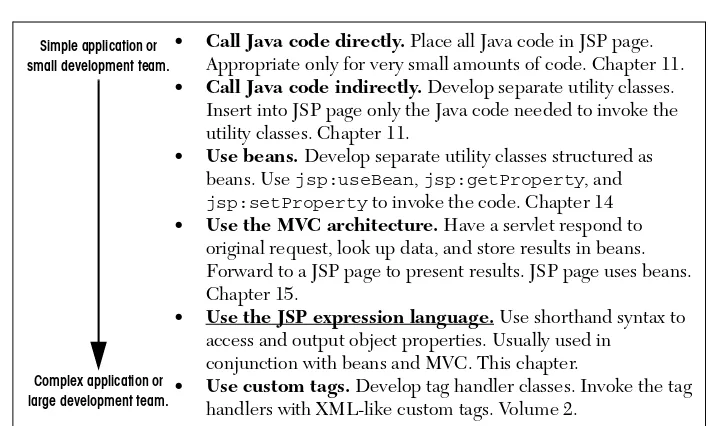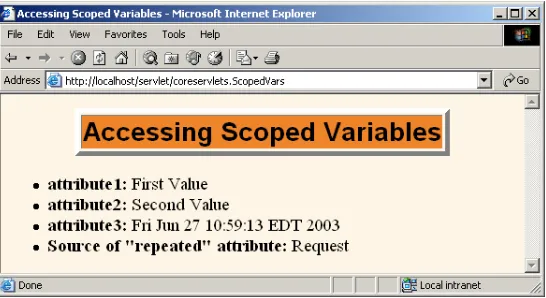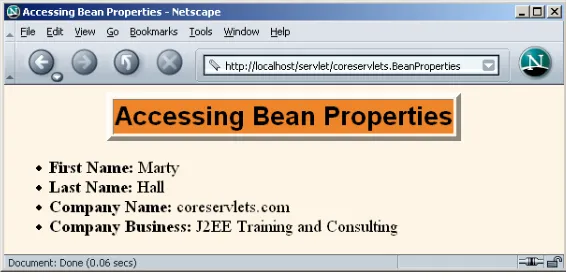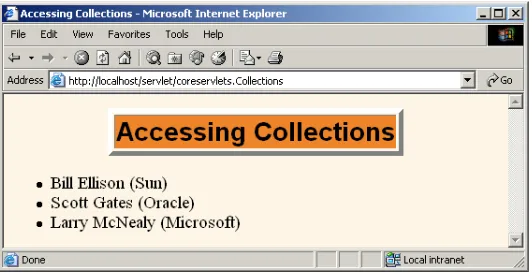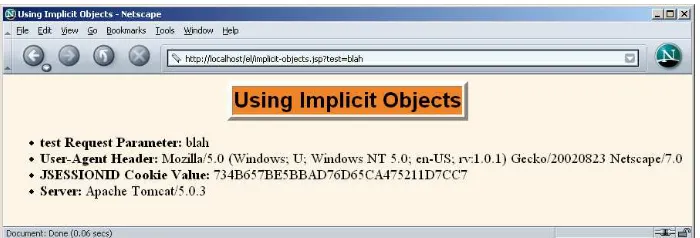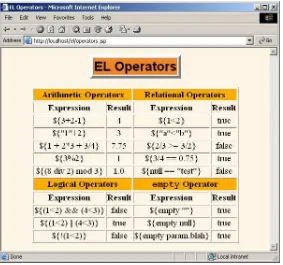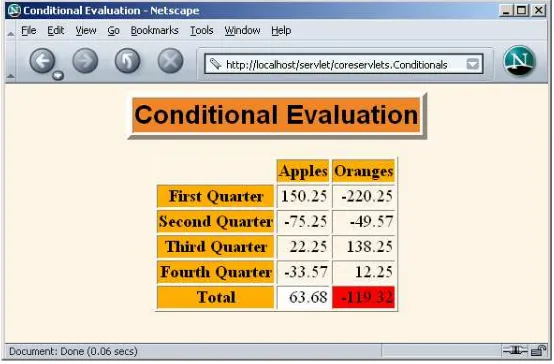Training courses from the book’s author:
http://courses.coreservlets.com/
• Personally developed and taught by Marty Hall • Available onsite at your organization (any country) • Topics and pace can be customized for your developers • Also available periodically at public venues
• Topics include Java programming, beginning/intermediate servlets and JSP, advanced servlets and JSP, Struts, JSF/MyFaces, Ajax, GWT, Ruby/Rails and more. Ask for custom courses!
JSP 2.0 E
XPRESSION
L
ANGUAGE
Topics in This Chapter
• Motivating use of the expression language
• Invoking the expression language
• Disabling the expression language
• Preventing the use of classic scripting elements
• Understanding the relationship of the expression
language to the MVC architecture
• Referencing scoped variables
• Accessing bean properties, array elements,
List
elements, and
Map
entries
Training courses from the book’s author:
http://courses.coreservlets.com/
• Personally developed and taught by Marty Hall • Available onsite at your organization (any country) • Topics and pace can be customized for your developers • Also available periodically at public venues
• Topics include Java programming, beginning/intermediate servlets and JSP, advanced servlets and JSP, Struts, JSF/MyFaces, Ajax, GWT, Ruby/Rails and more. Ask for custom courses!
16
JSP 2.0 introduced a shorthand language for evaluating and outputting the values of Java objects that are stored in standard locations. This expression language (EL) is one of the two most important new features of JSP 2.0; the other is the ability to define custom tags with JSP syntax instead of Java syntax. This chapter discusses the expression language; Volume 2 discusses the new tag library capabilities.
Core Warning
The JSP expression language cannot be used in servers that support only JSP 1.2 or earlier.
16.1 Motivating EL Usage
As illustrated in Figure 16–1, there are a number of different strategies that JSP pages can use to invoke Java code. One of the best and most flexible options is the MVC approach (see Chapter 15). In that approach, a servlet responds to the request; invokes the appropriate business logic or data access code; places the resultant data in beans; stores the beans in the request, session, or servlet context; and forwards the request to a JSP page to present the result.
F
o
r additional inf
o
rmation, please see the section on the JSF EL in
JSF tutorial at http://cor
eser
Figure 16–1 Strategies for invoking dynamic code from JSP.
The one inconvenient part about this approach is the final step: presenting the results in the JSP page. You normally use jsp:useBean and jsp:getProperty, but these elements are a bit verbose and clumsy. Furthermore, jsp:getProperty only supports access to simple bean properties; if the property is a collection or another bean, accessing the “subproperties” requires you to use complex Java syntax (precisely the thing you are often trying to avoid when using the MVC approach).
The JSP 2.0 expression language lets you simplify the presentation layer by replac-ing hard-to-maintain Java scriptreplac-ing elements or clumsy jsp:useBean and jsp:getProperty elements with short and readable entries of the following form.
${expression}
In particular, the expression language supports the following capabilities.
• Concise access to stored objects. To output a “scoped variable” (object stored with setAttribute in the PageContext, HttpServletRequest, HttpSession, or ServletContext) named saleItem, you use ${saleItem}. See Section 16.5. • Shorthand notation for bean properties. To output the
companyName property (i.e., result of the getCompanyName method) of a scoped variable named company, you use
${company.companyName}. To access the firstName property of the president property of a scoped variable named company, you use ${company.president.firstName}. See Section 16.6. Simple application or
small development team.
Complex application or large development team.
• Call Java code directly. Place all Java code in JSP page. Appropriate only for very small amounts of code. Chapter 11. • Call Java code indirectly. Develop separate utility classes.
Insert into JSP page only the Java code needed to invoke the utility classes. Chapter 11.
• Use beans. Develop separate utility classes structured as beans. Use jsp:useBean, jsp:getProperty, and jsp:setProperty to invoke the code. Chapter 14 • Use the MVC architecture. Have a servlet respond to
original request, look up data, and store results in beans. Forward to a JSP page to present results. JSP page uses beans. Chapter 15.
• Use the JSP expression language. Use shorthand syntax to access and output object properties. Usually used in
conjunction with beans and MVC. This chapter.
16.2 Invoking the Expression Language 467
• Simple access to collection elements. To access an element of an array, List, or Map, you use ${variable[indexOrKey]}. Provided that the index or key is in a form that is legal for Java variable names, the dot notation for beans is interchangeable with the bracket notation for collections. See Section 16.7.
• Succinct access to request parameters, cookies, and other request data. To access the standard types of request data, you can use one of several predefined implicit objects. See Section 16.8. • A small but useful set of simple operators. To manipulate objects
within EL expressions, you can use any of several arithmetic, relational, logical, or empty-testing operators. See Section 16.9. • Conditional output. To choose among output options, you do not
have to resort to Java scripting elements. Instead, you can use ${test ? option1 : option2}. See Section 16.10.
• Automatic type conversion. The expression language removes the need for most typecasts and for much of the code that parses strings as numbers.
• Empty values instead of error messages. In most cases, missing values or NullPointerExceptions result in empty strings, not thrown exceptions.
16.2 Invoking the Expression
Language
In JSP 2.0, you invoke the expression language with elements of the following form.
${expression}
These EL elements can appear in ordinary text or in JSP tag attributes, provided that those attributes permit regular JSP expressions. For example:
<UL>
<LI>Name: ${expression1}
<LI>Address: ${expression2}
</UL>
<jsp:include page="${expression3}" />
When you use the expression language in tag attributes, you can use multiple expressions (possibly intermixed with static text) and the results are coerced to strings and concatenated. For example:
This chapter will illustrate the use of expression language elements in ordinary text. Volume 2 of this book will illustrate the use of EL elements in attributes of tags that you write and tags that are provided by the JSP Standard Tag Library (JSTL) and JavaServer Faces (JSF) libraries.
Escaping Special Characters
If you want ${ to appear in the page output, use \${ in the JSP page. If you want to use a single or double quote within an EL expression, use \' and \", respectively.
16.3 Preventing Expression
Language Evaluation
In JSP 1.2 and earlier, strings of the form ${...} had no special meaning. So, it is possible that the characters ${ appear within a previously created page that is now being used on a server that supports JSP 2.0. In such a case, you need to deactivate the expression language in that page. You have four options for doing so.
• Deactivating the expression language in an entire Web application. You use a web.xml file that refers to servlets 2.3 (JSP 1.2) or earlier. See the first following subsection for details. • Deactivating the expression language in multiple JSP pages.
You use the jsp-property-groupweb.xml element to designate
the appropriate pages. See the second following subsection for details. • Deactivating the expression language in individual JSP pages.
You use the isELEnabled attribute of the page directive. See the third following subsection for details.
• Deactivating individual expression language statements. In JSP 1.2 pages that need to be ported unmodified across multiple JSP versions (with no web.xml changes), you can replace $ with $, the HTML character entity for $. In JSP 2.0 pages that contain both expression language statements and literal ${ strings, you can use \${ when you want ${ in the output.
16.3 Preventing Expression Language Evaluation 469
Deactivating the Expression Language
in an Entire Web Application
The JSP 2.0 expression language is automatically deactivated in Web applications whose deployment descriptor (i.e., WEB-INF/web.xml file) refers to servlet specifica-tion version 2.3 or earlier (i.e., JSP 1.2 or earlier). The web.xml file is discussed in great detail in the second volume of the book, but this volume provides a quick intro-duction in Section 2.11 (Web Applications: A Preview). For example, the following empty-but-legal web.xml file is compatible with JSP 1.2, and thus indicates that the expression language should be deactivated by default.
<?xml version="1.0" encoding="ISO-8859-1"?> <!DOCTYPE web-app
PUBLIC "-//Sun Microsystems, Inc.//DTD Web Application 2.3//EN" "http://java.sun.com/dtd/web-app_2_3.dtd">
<web-app> </web-app>
On the other hand, the following web.xml file is compatible with JSP 2.0, and thus
stipulates that the expression language should be activated by default. (Both of these
web.xml files, like all code examples presented in the book, can be downloaded from
the book’s source code archive at http://www.coreservlets.com/).
<?xml version="1.0" encoding="ISO-8859-1"?> <web-app xmlns="http://java.sun.com/xml/ns/j2ee"
xmlns:xsi="http://www.w3.org/2001/XMLSchema-instance" xsi:schemaLocation=
"http://java.sun.com/xml/ns/j2ee web-app_2_4.xsd" version="2.4">
</web-app>
Deactivating the Expression
Language in Multiple JSP Pages
In a Web application whose deployment descriptor specifies servlets 2.4 (JSP 2.0), you use the el-ignored subelement of the jsp-property-groupweb.xml
ele-ment to designate the pages in which the expression language should be ignored. Here is an example that deactivates the expression language for all JSP pages in the
<?xml version="1.0" encoding="ISO-8859-1"?> <web-app xmlns="http://java.sun.com/xml/ns/j2ee"
xmlns:xsi="http://www.w3.org/2001/XMLSchema-instance" xsi:schemaLocation=
"http://java.sun.com/xml/ns/j2ee web-app_2_4.xsd" version="2.4">
<jsp-property-group>
<url-pattern>/legacy/*.jsp</url-pattern> <el-ignored>true</el-ignored>
</jsp-property-group> </web-app>
The jsp-property-group element is discussed in more detail in Volume 2 of this book.
Deactivating the Expression
Language in Individual JSP Pages
To disable EL evaluation in an individual page, supply false as the value of the isELEnabled attribute of the page directive, as follows.
<%@ page isELEnabled="false" %>
Note that the isELEnabled attribute is new in JSP 2.0 and it is an error to use it in a server that supports only JSP 1.2 or earlier. So, you cannot use this technique to allow the same JSP page to run in either old or new servers without modification. Consequently, the jsp-property-group element is usually a better choice than the isELEnabled attribute.
Deactivating Individual Expression
Language Statements
Suppose you have a JSP 1.2 page containing ${ that you want to use in multiple places. In particular, you want to use it in both JSP 1.2 Web applications and in Web applications that contain expression language pages. You want to be able to drop the page in any Web application without making any changes either to it or to the
web.xml file. Although this is an unlikely scenario, it could happen, and none of the previously discussed constructs will serve the purpose. In such a case, you simply replace the $ with the HTML character entity corresponding to the ISO 8859-1 value of $ (36). So, you replace ${ with ${ throughout the page. For example,
${blah}
16.4 Preventing Use of Standard Scripting Elements 471
${blah}
to the user. Note, however, that the character entity is translated to $ by the browser, not by the server, so this technique will only work when you are outputting HTML to a Web browser.
Finally, suppose you have a JSP 2.0 page that contains both expression language statements and literal ${ strings. In such a case, simply put a backslash in front of the dollar sign. So, for example,
\${1+1} is ${1+1}.
will output
${1+1} is 2.
16.4 Preventing Use of Standard
Scripting Elements
The JSP expression language provides succinct and easy-to-read access to scoped variables (Java objects stored in the standard locations). This capability eliminates much of the need for the explicit Java scripting elements described in Chapter 11. In fact, some developers prefer to use a no-classic-scripting-elements approach throughout their entire projects. You can use the scripting-invalid subelement of jsp-property-group to enforce this restriction. For example, the following
web.xml file indicates that use of classic scripting elements in any JSP page will result
in an error.
<?xml version="1.0" encoding="ISO-8859-1"?> <web-app xmlns="http://java.sun.com/xml/ns/j2ee"
xmlns:xsi="http://www.w3.org/2001/XMLSchema-instance" xsi:schemaLocation=
"http://java.sun.com/xml/ns/j2ee web-app_2_4.xsd" version="2.4">
<jsp-property-group>
<url-pattern>*.jsp</url-pattern>
<scripting-invalid>true</scripting-invalid>
16.5 Accessing Scoped Variables
When you use the MVC approach (Chapter 15), a servlet invokes code that creates the data, then uses RequestDispatcher.forward or response.sendRedirect to transfer control to the appropriate JSP page. To permit the JSP page to access the data, the servlet needs to use setAttribute to store the data in one of the standard loca-tions: the HttpServletRequest, the HttpSession, or the ServletContext.
Objects in these locations are known as “scoped variables,” and the expression lan-guage has a quick and easy way to access them. You can also have scoped variables stored in the PageContext object, but this is much less useful because the servlet and the JSP page do not share PageContext objects. So, page-scoped variables apply only to objects stored earlier in the same JSP page, not to objects stored by a servlet.
To output a scoped variable, you simply use its name in an expression language element. For example,
${name}
means to search the PageContext, HttpServletRequest, HttpSession, and ServletContext (in that order) for an attribute named name. If the attribute is found, its toString method is called and that result is returned. If nothing is found, an empty string (not null or an error message) is returned. So, for example, the fol-lowing two expressions are equivalent.
${name}
<%= pageContext.findAttribute("name") %>
The problems with the latter approach are that it is verbose and it requires explicit Java syntax. It is possible to eliminate the Java syntax, but doing so requires the fol-lowing even more verbose jsp:useBean code.
<jsp:useBean id="name" type="somePackage.SomeClass" scope="..."> <%= name %>
16.5 Accessing Scoped Variables 473
Choosing Attribute Names
To use the JSP expression language to access scoped variables, you must choose attribute names that would be legal as Java variable names. So, avoid dots, spaces, dashes, and other characters that are permitted in strings but forbidden in variable names.
Also, you should avoid using attribute names that conflict with any of the pre-defined names given in Section 16.8.
An Example
To illustrate access to scoped variables, the ScopedVars servlet (Listing 16.1) stores a String in the HttpServletRequest, another String in the HttpSession, and a Date in the ServletContext. The servlet forwards the request to a JSP page (Listing 16.2, Figure 16–2) that uses ${attributeName} to access and out-put the objects.
Notice that the JSP page uses the same syntax to access the attributes, regardless of the scope in which they were stored. This is usually a convenient feature because MVC servlets almost always use unique attribute names for the objects they store. However, it is technically possible for attribute names to be repeated, so you should be aware that the expression language searches the PageContext, HttpServlet-Request, HttpSession, and ServletContextin that order. To illustrate this, the servlet stores an object in each of the three shared scopes, using the attribute name repeated in all three cases. The value returned by ${repeated} (see Fig-ure 16–2) is the first attribute found when searching the scopes in the defined order (i.e., the HttpServletRequest in this case). Refer to Section 16.8 (Referencing Implicit Objects) if you want to restrict the search to a particular scope.
Listing 16.1
ScopedVars.java
package coreservlets;
/** Servlet that creates some scoped variables (objects stored * as attributes in one of the standard locations). Forwards * to a JSP page that uses the expression language to
* display the values. */
public class ScopedVars extends HttpServlet { public void doGet(HttpServletRequest request, HttpServletResponse response) throws ServletException, IOException {
request.setAttribute("attribute1", "First Value");
HttpSession session = request.getSession();
session.setAttribute("attribute2", "Second Value");
ServletContext application = getServletContext(); application.setAttribute("attribute3",
new java.util.Date());
request.setAttribute("repeated", "Request"); session.setAttribute("repeated", "Session");
application.setAttribute("repeated", "ServletContext");
RequestDispatcher dispatcher =
request.getRequestDispatcher("/el/scoped-vars.jsp"); dispatcher.forward(request, response);
} }
Listing 16.2
scoped-vars.jsp
<!DOCTYPE HTML PUBLIC "-//W3C//DTD HTML 4.0 Transitional//EN"> <HTML>
<HEAD><TITLE>Accessing Scoped Variables</TITLE> <LINK REL=STYLESHEET
HREF="/el/JSP-Styles.css" TYPE="text/css">
</HEAD> <BODY>
<TABLE BORDER=5 ALIGN="CENTER"> <TR><TH CLASS="TITLE">
Accessing Scoped Variables </TABLE>
<P> <UL>
<LI><B>attribute1:</B> ${attribute1}
<LI><B>attribute2:</B> ${attribute2}
<LI><B>attribute3:</B> ${attribute3}
<LI><B>Source of "repeated" attribute:</B> ${repeated}
</UL>
</BODY></HTML>
16.6 Accessing Bean Properties 475
Figure 16–2 The JSP 2.0 expression language simplifies access to scoped variables: objects stored as attributes of the page, request, session, or servlet context.
16.6 Accessing Bean Properties
When you simply use ${name}, the system finds the object named name, coerces it to a String, and returns it. Although this behavior is convenient, you rarely want to output the actual object that the MVC servlet stored. Rather, you typically want to output individual properties of that object.
The JSP expression language provides a simple but very powerful dot notation for accessing bean properties. To return the firstName property of a scoped variable named customer, you merely use ${customer.firstName}. Although this form appears very simple, the system must perform reflection (analysis of the internals of the object) to support this behavior. So, assuming the object is of type NameBean and that NameBean is in the coreservlets package, to do the same thing with explicit Java syntax, you would have to replace
${customer.firstName}
with
<%@ page import="coreservlets.NameBean" %> <%
NameBean person =
(NameBean)pageContext.findAttribute("customer"); %>
Furthermore, the version with the JSP expression language returns an empty string if the attribute is not found, whereas the scripting element version would need additional code to avoid a NullPointerException in the same situation.
Now, JSP scripting elements are not the only alternative to use of the expression language. As long as you know the scope and fully qualified class name, you could replace
${customer.firstName}
with
<jsp:useBean id="customer" type="coreservlets.NameBean" scope="request, session, or application" /> <jsp:getProperty name="customer" property="firstName" />
However, the expression language lets you nest properties arbitrarily. For exam-ple, if the NameBean class had an address property (i.e., a getAddress method) that returned an Address object with a zipCode property (i.e., a getZipCode method), you could access this zipCode property with the following simple form.
${customer.address.zipCode}
There is no combination of jsp:useBean and jsp:getProperty that lets you do the same thing without explicit Java syntax.
Equivalence of Dot Notation
and Array Notation
Finally, note that the expression language lets you replace dot notation with array notation (square brackets). So, for example, you can replace
${name.property}
with
${name["property"]}
The second form is rarely used with bean properties. However, it does have two advantages.
First, it lets you compute the name of the property at request time. With the array notation, the value inside the brackets can itself be a variable; with dot notation the property name must be a literal value.
16.6 Accessing Bean Properties 477
An Example
To illustrate the use of bean properties, consider the BeanProperties servlet of List-ing 16.3. The servlet creates an EmployeeBean (Listing 16.4), stores it in the request object with an attribute named employee, and forwards the request to a JSP page.
The EmployeeBean class has name and company properties that refer to Name-Bean (Listing 16.5) and CompanyBean (Listing 16.6) objects, respectively. The NameBean class has firstName and lastName properties and the CompanyBean class has companyName and business properties. The JSP page (Listing 16.7) uses the following simple EL expressions to access the four attributes:
${employee.name.firstName}
/** Servlet that creates some beans whose properties will * be displayed with the JSP 2.0 expression language. */
import java.io.*; import javax.servlet.*; import javax.servlet.http.*;
public class BeanProperties extends HttpServlet { public void doGet(HttpServletRequest request, HttpServletResponse response) throws ServletException, IOException { NameBean name = new NameBean("Marty", "Hall"); CompanyBean company =
new CompanyBean("coreservlets.com",
"J2EE Training and Consulting"); EmployeeBean employee = new EmployeeBean(name, company); request.setAttribute("employee", employee);
RequestDispatcher dispatcher =
request.getRequestDispatcher("/el/bean-properties.jsp"); dispatcher.forward(request, response);
Listing 16.4
EmployeeBean.java
package coreservlets;
public class EmployeeBean { private NameBean name; private CompanyBean company;
public EmployeeBean(NameBean name, CompanyBean company) { setName(name);
setCompany(company); }
public NameBean getName() { return(name); } public void setName(NameBean newName) { name = newName;
}
public CompanyBean getCompany() { return(company); } public void setCompany(CompanyBean newCompany) { company = newCompany;
} }
Listing 16.5
NameBean.java
package coreservlets;
public class NameBean {
private String firstName = "Missing first name"; private String lastName = "Missing last name";
public NameBean() {}
public NameBean(String firstName, String lastName) { setFirstName(firstName);
setLastName(lastName); }
public String getFirstName() { return(firstName);
16.6 Accessing Bean Properties 479
public void setFirstName(String newFirstName) { firstName = newFirstName;
}
public String getLastName() { return(lastName);
}
public void setLastName(String newLastName) { lastName = newLastName;
} }
Listing 16.6
CompanyBean.java
package coreservlets;
public class CompanyBean { private String companyName; private String business;
public CompanyBean(String companyName, String business) { setCompanyName(companyName);
setBusiness(business); }
public String getCompanyName() { return(companyName); } public void setCompanyName(String newCompanyName) { companyName = newCompanyName;
}
public String getBusiness() { return(business); } public void setBusiness(String newBusiness) { business = newBusiness;
} }
Figure 16–3 You use dots or array notation to access bean properties.
Listing 16.7
bean-properties.jsp
<!DOCTYPE HTML PUBLIC "-//W3C//DTD HTML 4.0 Transitional//EN"> <HTML>
<HEAD><TITLE>Accessing Bean Properties</TITLE> <LINK REL=STYLESHEET
HREF="/el/JSP-Styles.css" TYPE="text/css">
</HEAD> <BODY>
<TABLE BORDER=5 ALIGN="CENTER"> <TR><TH CLASS="TITLE">
Accessing Bean Properties </TABLE>
<P> <UL>
<LI><B>First Name:</B> ${employee.name.firstName}
<LI><B>Last Name:</B> ${employee.name.lastName}
<LI><B>Company Name:</B> ${employee.company.companyName}
<LI><B>Company Business:</B> ${employee.company.business}
</UL>
16.7 Accessing Collections 481
16.7 Accessing Collections
The JSP 2.0 expression language lets you access different types of collections in the same way: using array notation. For instance, if attributeName is a scoped vari-able referring to an array, List, or Map, you access an entry in the collection with the following:
${attributeName[entryName]}
If the scoped variable is an array, the entry name is the index and the value is obtained with theArray[index]. For example, if customerNames refers to an array of strings,
${customerNames[0]}
would output the first entry in the array.
If the scoped variable is an object that implements the List interface, the entry name is the index and the value is obtained with theList.get(index). For exam-ple, if supplierNames refers to an ArrayList,
${supplierNames[0]}
would output the first entry in the ArrayList.
If the scoped variable is an object that implements the Map interface, the entry name is the key and the value is obtained with theMap.get(key). For example, if stateCapitals refers to a HashMap whose keys are U.S. state names and whose values are city names,
${stateCapitals["maryland"]}
would return "annapolis". If the Map key is of a form that would be legal as a Java variable name, you can replace the array notation with dot notation. So, the previous example could also be written as:
${stateCapitals.maryland}
However, note that the array notation lets you choose the key at request time, whereas the dot notation requires you to know the key in advance.
An Example
Purely numeric values are illegal as bean properties, so the array and ArrayList entries must be accessed with array notation. However, the HashMap entries could be accessed with either array or dot notation. We use array notation for consistency, but, for example,
/** Servlet that creates some collections whose elements will * be displayed with the JSP 2.0 expression language.
* <P> */
import java.io.*; import javax.servlet.*; import javax.servlet.http.*;
public class Collections extends HttpServlet { public void doGet(HttpServletRequest request, HttpServletResponse response) throws ServletException, IOException {
String[] firstNames = { "Bill", "Scott", "Larry" }; ArrayList lastNames = new ArrayList();
lastNames.add("Ellison"); lastNames.add("Gates"); lastNames.add("McNealy");
HashMap companyNames = new HashMap(); companyNames.put("Ellison", "Sun"); companyNames.put("Gates", "Oracle"); companyNames.put("McNealy", "Microsoft"); request.setAttribute("first", firstNames); request.setAttribute("last", lastNames); request.setAttribute("company", companyNames); RequestDispatcher dispatcher =
request.getRequestDispatcher("/el/collections.jsp"); dispatcher.forward(request, response);
16.8 Referencing Implicit Objects 483
Figure 16–4 You use array notation or dots to access collections. Dots can be used only when the key is in a form that would be legal as a Java variable name.
16.8 Referencing Implicit Objects
In most cases, you use the JSP expression language in conjunction with the Model-View-Controller architecture (Chapter 15) in which the servlet creates the data and the JSP page presents the data. In such a scenario, the JSP page is usually only
inter-Listing 16.9
collections.jsp
<!DOCTYPE HTML PUBLIC "-//W3C//DTD HTML 4.0 Transitional//EN"> <HTML>
<HEAD><TITLE>Accessing Collections</TITLE> <LINK REL=STYLESHEET
HREF="/el/JSP-Styles.css" TYPE="text/css">
</HEAD> <BODY>
<TABLE BORDER=5 ALIGN="CENTER"> <TR><TH CLASS="TITLE">
Accessing Collections </TABLE>
<P> <UL>
<LI>${first[0]} ${last[0]} (${company["Ellison"]}) <LI>${first[1]} ${last[1]} (${company["Gates"]}) <LI>${first[2]} ${last[2]} (${company["McNealy"]}) </UL>
ested in the objects that the servlet created, and the general bean-access and collec-tion-access mechanisms are sufficient.
However, the expression language is not restricted to use in the MVC approach; if the server supports JSP 2.0 and the web.xml file refers to servlets 2.4, the expression
language can be used in any JSP page. To make this capability useful, the specifica-tion defines the following implicit objects.
pageContext
The pageContext object refers to the PageContext of the current page. The PageContext class, in turn, has request, response, session, out, and servletContext properties (i.e., getRequest, getResponse, getSession, getOut, and getServletContext methods). So, for example, the following outputs the current session ID.
${pageContext.session.id}
param and paramValues
These objects let you access the primary request parameter value (param) or the array of request parameter values (paramValues). So, for example, the following outputs the value of the custID request parameter (with an empty string, not null, returned if the parameter does not exist in the current request).
${param.custID}
For more information on dealing with request parameters, see Chapter 4.
header and headerValues
These objects access the primary and complete HTTP request header values, respectively. Remember that dot notation cannot be used when the value after the dot would be an illegal property name. So, for example, to access the Accept header, you could use either
${header.Accept}
or
${header["Accept"]}
But, to access the Accept-Encoding header, you must use
${header["Accept-Encoding"]}
16.8 Referencing Implicit Objects 485
cookie
The cookie object lets you quickly reference incoming cookies. However, the return value is the Cookie object, not the cookie value. To access the value, use the standard value property (i.e., the getValue method) of the Cookie class. So, for example, either of the following outputs the value of the cookie named userCookie (or an empty string if no such cookie is found).
${cookie.userCookie.value} ${cookie["userCookie"].value}
For more information on using cookies, see Chapter 8.
initParam
The initParam object lets you easily access context initialization parameters. For example, the following outputs the value of the init param named
defaultColor.
${initParam.defaultColor}
For more information on using initialization parameters, see Volume 2 of this book.
pageScope, requestScope, sessionScope, and applicationScope
These objects let you restrict where the system looks for scoped variables. For example, with
${name}
the system searches for name in the PageContext, the HttpServlet-Request, the HttpSession, and the ServletContext, returning the first match it finds. On the other hand, with
${requestScope.name}
the system only looks in the HttpServletRequest.
An Example
Figure 16–5 A number of scoped variables are defined automatically. These predefined variables are called “implicit objects.”
Listing 16.10
implicit-objects.jsp
<!DOCTYPE HTML PUBLIC "-//W3C//DTD HTML 4.0 Transitional//EN"> <HTML>
<HEAD><TITLE>Using Implicit Objects</TITLE> <LINK REL=STYLESHEET
HREF="/el/JSP-Styles.css" TYPE="text/css">
</HEAD> <BODY>
<TABLE BORDER=5 ALIGN="CENTER"> <TR><TH CLASS="TITLE">
Using Implicit Objects </TABLE>
<P> <UL>
<LI><B>test Request Parameter:</B> ${param.test}
<LI><B>User-Agent Header:</B> ${header["User-Agent"]}
<LI><B>JSESSIONID Cookie Value:</B> ${cookie.JSESSIONID.value}
<LI><B>Server:</B> ${pageContext.servletContext.serverInfo}
</UL>
16.9 Using Expression Language Operators 487
16.9 Using Expression
Language Operators
The JSP 2.0 expression language defines a number of arithmetic, relational, logical, and missing-value-testing operators. Although use of the operators often results in code that is a bit shorter than the equivalent Java code, you should keep in mind the main purpose of the expression language: to provide concise access to existing objects, usually in the context of the MVC architecture. So, we see little benefit in replacing long and complex scripting elements with only slightly shorter expression language elements. Both approaches are wrong; complex business- or data-access-logic does not belong in JSP pages at all. As much as possible, restrict the use of the expression language to presentation logic; keep the business logic in normal Java classes that are invoked by servlets.
Core Approach
Use the expression language operators for simple tasks oriented toward presentation logic (deciding how to present the data). Avoid using the operators for business logic (creating and processing the data). Instead, put business logic in regular Java classes and invoke the code from the servlet that starts the MVC process.
Arithmetic Operators
These operators are typically used to perform simple manipulation of values already stored in beans. Resist using them for complex algorithms; put such code in regular Java code instead.
+ and –
*
, /, and div
These are the normal multiplication and division operators, with a few excep-tions. First, types are converted automatically as with the + and – operators. Second, the normal arithmetic operator precedence applies, so, for instance,
${ 1 + 2 * 3}
returns 7, not 9. You can use parentheses to change the operator precedence. Third, the / and div operators are equivalent; both are provided for the sake of compatibility with both XPath and JavaScript (ECMAScript).
% and mod
The % (or equivalently, mod) operator computes the modulus (remainder), just as with % in the Java programming language.
Relational Operators
These operators are most frequently used with either the JSP expression language conditional operator (Section 16.10) or with custom tags whose attributes expect boolean values (e.g., looping tags like those in the JSP Standard Tag Library— JSTL—as discussed in Volume 2 of this book).
== and eq
These two equivalent operators check whether the arguments are equal. How-ever, they operate more like the Java equals method than the Java == opera-tor. If the two operands are the same object, true is returned. If the two operands are numbers, they are compared with Java ==. If either operand is null, false is returned. If either operand is a BigInteger or BigDecimal, the operands are compared with compareTo. Otherwise, the operands are compared with equals.
!= and ne
16.9 Using Expression Language Operators 489
< and lt, > and gt, <= and le, >= and ge
These are the standard arithmetic operators with two exceptions. First, type conversions are performed as with == and !=. Second, if the arguments are strings, they are compared lexically.
Logical Operators
These operators are used to combine results from the relational operators.
&&, and, ||, or, !, not
These are the standard logical AND, OR, and NOT operators. They operate by coercing their arguments to Boolean, and they use the normal Java “short cir-cuit” evaluation in which the testing is stopped as soon as the result can be determined. && and and are equivalent, || and or are equivalent, and ! and not are equivalent.
The empty Operator
empty
This operator returns true if its argument is null, an empty string, an empty array, an empty Map, or an empty collection. Otherwise it returns false.
An Example
Listing 16.11 illustrates several of the standard operators; Figure 16–6 shows the result.
Listing 16.11
operators.jsp
<!DOCTYPE HTML PUBLIC "-//W3C//DTD HTML 4.0 Transitional//EN"> <HTML>
<HEAD><TITLE>EL Operators</TITLE> <LINK REL=STYLESHEET
HREF="/el/JSP-Styles.css" TYPE="text/css">
</HEAD> <BODY>
<TABLE BORDER=5 ALIGN="CENTER"> <TR><TH CLASS="TITLE">
<P>
<TABLE BORDER=1 ALIGN="CENTER">
<TR><TH CLASS="COLORED" COLSPAN=2>Arithmetic Operators <TH CLASS="COLORED" COLSPAN=2>Relational Operators <TR><TH>Expression<TH>Result<TH>Expression<TH>Result <TR ALIGN="CENTER">
<TD>\${3+2-1}<TD>${3+2-1} <%-- Addition/Subtraction --%> <TD>\${1<2}<TD>${1<2} <%-- Numerical comparison --%> <TR ALIGN="CENTER">
<TD>\${"1"+2}<TD>${"1"+2} <%-- String conversion --%> <TD>\${"a"<"b"}<TD>${"a"<"b"} <%-- Lexical comparison --%> <TR ALIGN="CENTER">
<%-- Compares with "equals" but returns false for null --%> <TD>\${null == "test"}<TD>${null == "test"}
<TR><TH CLASS="COLORED" COLSPAN=2>Logical Operators
<TH CLASS="COLORED" COLSPAN=2><CODE>empty</CODE> Operator <TR><TH>Expression<TH>Result<TH>Expression<TH>Result
<TR ALIGN="CENTER">
<TD>\${(1<2) && (4<3)}<TD>${(1<2) && (4<3)} <%--AND--%> <TD>\${empty ""}<TD>${empty ""} <%-- Empty string --%>
<TR ALIGN="CENTER">
<TD>\${(1<2) || (4<3)}<TD>${(1<2) || (4<3)} <%--OR--%> <TD>\${empty null}<TD>${empty null} <%-- null --%>
<TR ALIGN="CENTER">
<TD>\${!(1<2)}<TD>${!(1<2)} <%-- NOT -%>
<%-- Handles null or empty string in request param --%> <TD>\${empty param.blah}<TD>${empty param.blah}
</TABLE> </BODY></HTML>
16.10 Evaluating Expressions Conditionally 491
Figure 16–6 The expression language defines a small set of operators. Use them with great restraint; invoke business logic from servlets, not from JSP pages.
16.10 Evaluating Expressions
Conditionally
The JSP 2.0 expression language does not, in itself, provide a rich conditional evalua-tion facility. That capability is provided by the c:if and c:choose tags of the JSP Standard Tag Library (JSTL) or by another custom tag library. (JSTL and the cre-ation of custom tag libraries are covered in Volume 2 of this book.)
However, the expression language supports the rudimentary ?: operator as in the Java, C, and C++ languages. For example, if test evaluates to true,
${ test ? expression1 : expression2 }
An Example
The servlet of Listing 16.12 creates two SalesBean objects (Listing 16.13) and for-wards the request to a JSP page (Listing 16.14) for presentation (Figure 16–7). How-ever, if the total sales number is negative, the JSP page wants to use a table cell with a red background. If it is negative, the page wants to use a white background. Imple-menting this behavior is a presentation task, so the ?: operator is appropriate.
Listing 16.12
Conditionals.java
package coreservlets;
/** Servlet that creates scoped variables that will be used * to illustrate the EL conditional operator (xxx ? xxx : xxx). */
import java.io.*; import javax.servlet.*; import javax.servlet.http.*;
public class Conditionals extends HttpServlet { public void doGet(HttpServletRequest request, HttpServletResponse response) throws ServletException, IOException { SalesBean apples =
new SalesBean(150.25, -75.25, 22.25, -33.57); SalesBean oranges =
new SalesBean(-220.25, -49.57, 138.25, 12.25); request.setAttribute("apples", apples);
request.setAttribute("oranges", oranges); RequestDispatcher dispatcher =
request.getRequestDispatcher("/el/conditionals.jsp"); dispatcher.forward(request, response);
16.10 Evaluating Expressions Conditionally 493
Listing 16.13
SalesBean.java
package coreservlets;
public class SalesBean {
private double q1, q2, q3, q4;
public SalesBean(double q1Sales, double q2Sales,
<!DOCTYPE HTML PUBLIC "-//W3C//DTD HTML 4.0 Transitional//EN"> <HTML>
<HEAD><TITLE>Conditional Evaluation</TITLE> <LINK REL=STYLESHEET
HREF="/el/JSP-Styles.css" TYPE="text/css">
Figure 16–7 You can use the C-style ?: operator to conditionally output different elements. However, the JSP Standard Tag Library (JSTL) is often a better alternative for this kind of conditional operation.
<TR><TH CLASS="COLORED">First Quarter <TD ALIGN="RIGHT">${apples.q1} <TD ALIGN="RIGHT">${oranges.q1} <TR><TH CLASS="COLORED">Second Quarter <TD ALIGN="RIGHT">${apples.q2} <TD ALIGN="RIGHT">${oranges.q2} <TR><TH CLASS="COLORED">Third Quarter <TD ALIGN="RIGHT">${apples.q3} <TD ALIGN="RIGHT">${oranges.q3} <TR><TH CLASS="COLORED">Fourth Quarter <TD ALIGN="RIGHT">${apples.q4} <TD ALIGN="RIGHT">${oranges.q4} <TR><TH CLASS="COLORED">Total <TD ALIGN="RIGHT"
BGCOLOR="${(apples.total < 0) ? "RED" : "WHITE" }"> ${apples.total}
<TD ALIGN="RIGHT"
BGCOLOR="${(oranges.total < 0) ? "RED" : "WHITE" }"> ${oranges.total}
</TABLE> </BODY></HTML>
16.11 Previewing Other Expression Language Capabilities 495
16.11 Previewing Other Expression
Language Capabilities
This chapter summarizes most of the capabilities of the JSP 2.0 expression language. However, there are two capabilities that we did not discuss here: the use of the expression language in tag libraries and the use of expression language functions. We postpone coverage of these two capabilities to Volume 2 because they require tech-niques covered only in the second volume of the book.
